Switzerland Train Travel: Understanding and using the Swiss Rail System
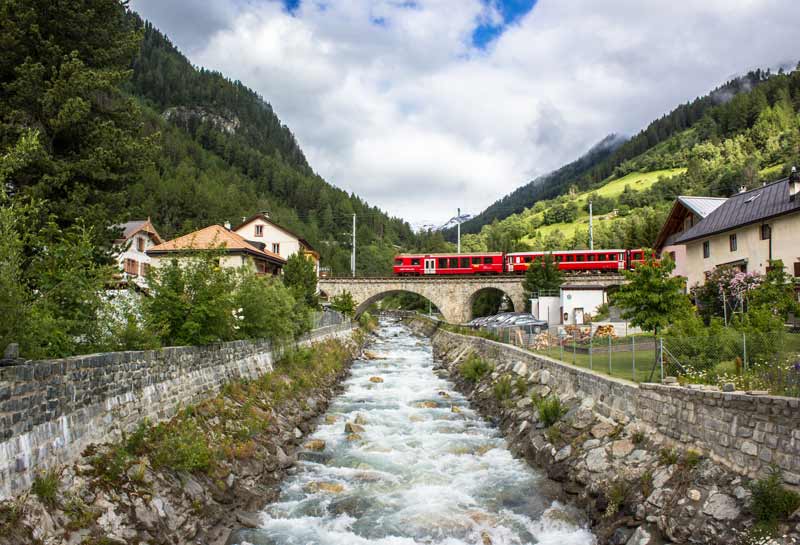
Switzerland is famous for its railways. The trains in Switzerland are known to be on time, clean and frequent and very often they also offer superb views. In fact, Switzerland’s rail, bus and boat network is widely regarded as the best public transport in the world.
The Swiss public transport network is operated by more than 250 public transport companies including train, bus, boat and mountain railways. We’ll cover all the essential information you need to know to travel by public transport in Switzerland in this article.
With the Switzerland railway and public transport network being so efficient, travelling by train is generally the best way to travel in Switzerland for both locals and visitors.
In this train travel in Switzerland guide, we explain the difference between a Swiss rail pass and regular Swiss train tickets, give you details about the major train routes in Switzerland, tell you where you can find a Swiss rail timetable, where to buy your Switzerland train tickets and how to make your Switzerland train reservations online.
[This post may contain compensated links. Please see my disclosure policy for more information.]

What's in this Article
Quick summary of the different Swiss rail tickets and Swiss rail passes available to tourists
| Swiss Travel Pass | BUY HERE |
| Swiss Travel Pass Flex | BUY HERE |
| Swiss Half Fare Card | BUY HERE |
| Point to point tickets | Swiss Railways |
| Jungfrau Travel Pass | BUY HERE |
| Berner Oberland Pass | BUY HERE |
| Tell Pass | BUY HERE |
| Seat reservations for panoramic trains | Direct with train operator |
Individual Switzerland Train Tickets vs a Swiss Rail Pass – Swiss Train Tickets Explained
In most cases when it comes to Swiss train tickets for tourists, you are going to be better off purchasing at least some form of Switzerland train pass rather than if you buy Switzerland rail tickets individually.
When it comes to purchasing individual tickets for train journeys in Switzerland, there are many variables that determine the price. The main factor is when you book the tickets as well as the timing of the actual train travel.
Booking last minute tickets tends to be most expensive, which means you can’t be very flexible with your travel.
You’ll also want to consider if you plan on doing any mountain excursions during your Switzerland travel as these day trips alone can make it well worth your while to purchase a pass.
We outline the various ticket and rail pass options below.
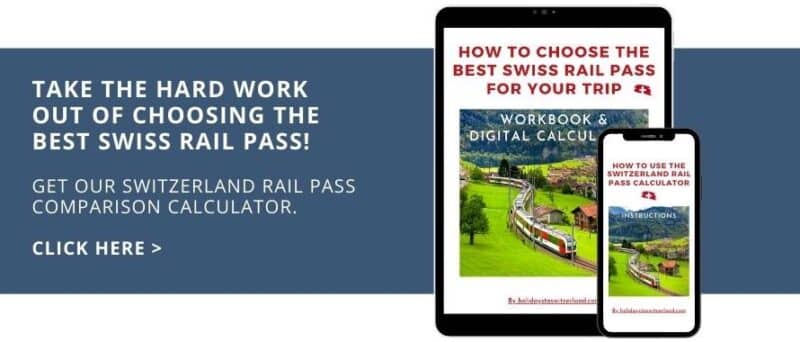
Swiss Travel Pass
The most convenient ticket option for use on public transport in Switzerland for tourists is the Swiss Travel Pass. This is an all-in-one ticket for the entire public transport network and it acts just like a hop on hop off ticket.
The Swiss Travel Pass can be purchased for use on consecutive days or you can select a Swiss Travel Pass Flex which entitles you to a specific number of travel days within a one month period.
🇨🇭 Read our detailed guide to the Swiss Travel Pass.
Swiss Half Fare Card
Another popular option when it comes to Swiss rail tickets is the Half Fare Card. With the Half Fare Card, you can buy point-to-point train tickets with a 50% reduction.
The Swiss Half Fare Card is valid for one month and half price tickets can also be purchased for mountain top excursions, boats and buses.
🇨🇭 Read our detailed guide to the Swiss Half Fare Card.
Point-to-point tickets
Should you only plan to do one or two trips by public transport, and are only travelling a short distance, a normal point-to-point ticket can also be an alternative at a good price.
When purchasing your point to point tickets, keep in mind that you need to specify the exact travel days. Subsequent changes or exchanges are not possible.
If you’re after cheap train tickets, Switzerland Railways sometimes have Super Saver Tickets available. There are a limited number of Super Saver tickets available on selected routes, which offer savings of up to 70%.
Super Saver tickets also have the option of first or second class travel as well as the additional half fare discount for holders of the Half Fare Card. These tickets (subject to availability) can be purchased between 1 and 60 days prior to travel.
Again, the Super Saver ticket is only valid for the selected date of travel.
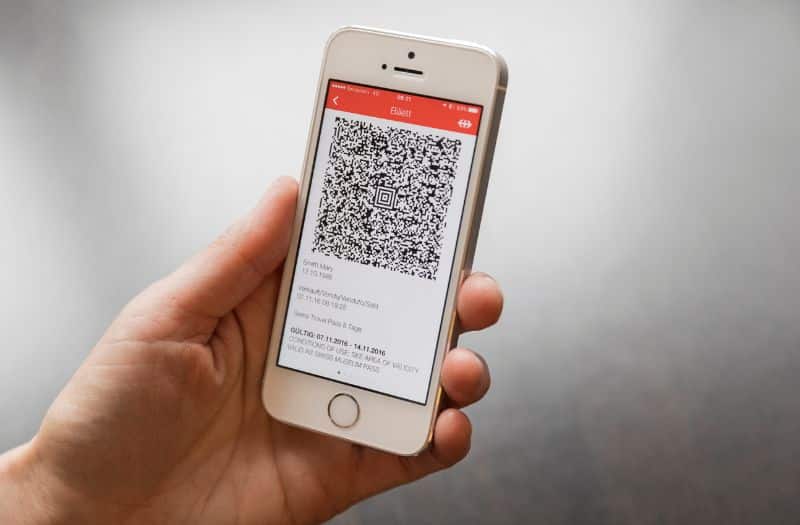
Child Fares
If you are travelling with children aged between 6 to 15 and not travelling with the Swiss Travel Pass, but instead with one of the other passes mentioned above or simply point to point tickets, it is recommended that you purchase a Junior Travel Card for CHF 30 for each child.
This card then allows children to travel free of charge alongside you. The card is valid wherever the Half Fare card is available and on many other transport services as well.
If you are travelling with a Swiss Travel Pass or Half Fare Card, you are better off obtaining the free Swiss Family Card as this entitles accompanied children to travel free of charge. We cover the Swiss Family Card in more detail in this article.
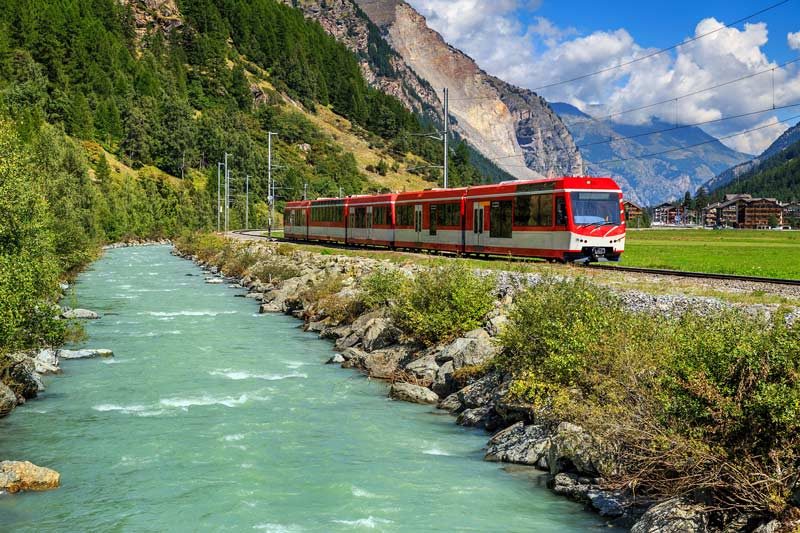
Where to buy Swiss train tickets and rail passes
Swiss Travel Pass
We highly recommend you buy your Swiss Travel Pass online before you leave home. This means you avoid long queues at the ticket counter in Switzerland and you can also conveniently hop on the first train, tram or bus on arrival in Switzerland.
Whilst you can buy Swiss Passes at most railway stations in Switzerland, buying your Swiss Travel Pass in advance also means that you can get this significant expense out of the way long before your vacation begins.
The Swiss Travel Pass is sent as a PDF via email so you can save it to your mobile device and print it out at home, which makes purchasing the Pass online super easy and convenient.
Click here to purchase your Swiss Train Pass and then as soon you arrive in Switzerland you can start taking advantage of all the benefits that come with the pass.
Also just to note that the Swiss Travel Pass is only available to be purchased by people who permanently live outside of Switzerland.
CLICK HERE TO BUY YOUR SWISS TRAVEL PASS
Swiss Half Fare Card
Just like the Swiss Travel Pass, we also recommend you buy the Swiss Half Fare Card online before you leave home. It can be purchased from any train station in Switzerland but you’ll skip the queues by buying it online.
CLICK HERE TO BUY YOUR SWISS HALF FARE CARD
Point-to-point tickets
If you are only doing a few short journeys, buying train tickets in Switzerland is easy. Larger stations have manned ticket counters which are open at specific times throughout the day but all stations have ticket machines.
The ticket machines are easy to use – you can select to display the instructions in English – and payment can be made by credit card.
You can also purchase point-to-point tickets on the Swiss Federal Railways website or the SBB Mobile app.
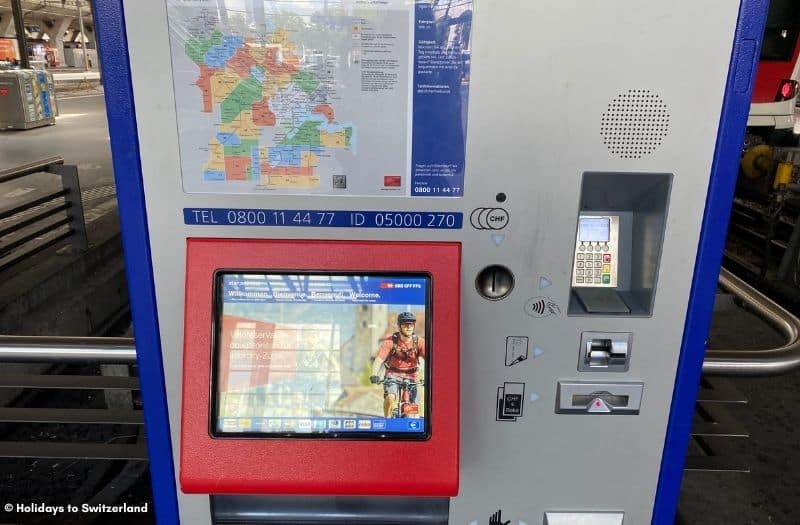
Regional Passes
In addition to the Swiss rail passes and point to point tickets mentioned above, there are other regional train passes in Switzerland for some of the more popular tourist regions in Switzerland.
Passes available include the Jungfrau Travel Pass for the Jungfrau region, Berner Oberland Pass for the Bernese Oberland including Jungfrau region, and the Tell Pass for the Lake Lucerne region.
These passes can be purchased locally but we recommend you purchase them online before you leave home. This will save you having to queue to purchase your tickets on arrival in Switzerland. You can buy them via the following links:
🇨🇭 Read our guide to choosing the best Swiss rail pass for your trip.
Seat reservations on Swiss trains
For most trains in Switzerland you do not need any reservations. On some longer distance Swiss trains you can make a seat reservation if you prefer to but it’s not compulsory.
On Switzerland’s scenic trains it is mandatory to make a seat reservation. This applies to the Bernina Express, Glacier Express, GoldenPass Express and Gotthard Panorama Express trains.
Also keep in mind that if you are crossing into many of the neighbouring countries you will most likely require a seat reservation.
It is essential that seat reservations are purchased before travel.
How to make seat reservations on Swiss trains
Seat reservations on regular trains
If you want to make a seat reservation for your train holidays to Switzerland you can do so via the SBB website, mobile app or at the ticket counter at a station.
If you’d like to guarantee a window seat on a specific train, for instance the Luzern-Interlaken Express, you may wish to make a seat reservation. It costs CHF 5 per seat to make a reservation on regular trains.
Seat reservations on panoramic trains
Seat reservations for the premium panoramic trains should be made directly on the official website of the train company. Seat reservations are compulsory for all passengers, including children (aged 6 and over) and holders of a Swiss Travel Pass.
Due to the popularity of the Swiss panoramic trains, it is highly recommended that you book your seat reservation as early as possible. Seat reservations are available to purchase from 90 days before travel.
You’ll find more information about the panoramic trains, and links to our detailed guides which include step-by-step instructions for purchasing seat reservations, below.
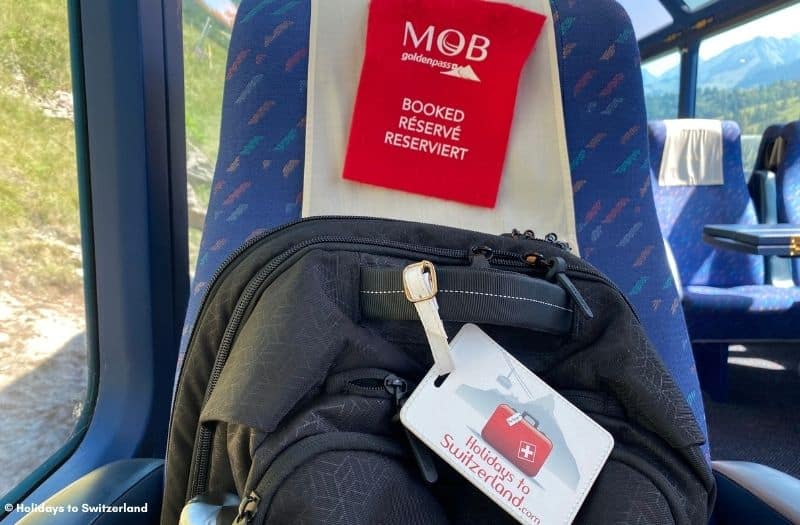
Travelling on public transport in Switzerland with a Swiss rail pass
After purchasing any of the Swiss rail passes that we’ve mentioned above, you will receive an email with your valid pass as a PDF attachment.
We recommend saving the PDF to the wallet on your mobile device or taking a screenshot of it which you can save to your device’s photos. You should also print a paper copy and upload a copy to the Cloud, just in case your battery goes flat or your phone gets lost or stolen.
If you have purchased a consecutive day Swiss Travel Pass (or a regional pass), you do not need to validate or activate your pass before travel.
However, if you have purchased a Swiss Travel Pass Flex, you must activate your pass prior to each day of travel. We cover the instructions to do this in detail in this article.
Travelling by train – Swiss Travel Pass instructions
On boarding the train, you can sit in any free seat in the correct class of travel. For example, if you have a 1st class rail pass you can sit anywhere in a 1st class carriage.
Seat reservations are not required on the majority of trains in Switzerland – exceptions are the premium panoramic trains, as we mentioned above.
Before boarding the train, look for the numbers 1 or 2 on the outside of each carriage so you know which carriage to get on.
When requested by the ticket inspector, you’ll be required to show your Swiss Travel Pass or your regional pass. No other tickets are required except in the case of panoramic trains when you will also be requested to show your seat reservation.
Travelling by bus – Swiss Travel Pass instructions
Most of the buses in Switzerland operate under the ‘self-control’ model. This means, if you are travelling with a Swiss Travel Pass, you do not need to show the pass to the driver upon entry.
You may board through any of the doors and sit wherever you wish.
Random ticket checks do occur so it’s your responsibility to ensure you carry your valid Swiss Travel Pass (or regional pass, if applicable) at all times.
There are still a few smaller bus lines where you need to show your pass to the bus driver, but you will notice when this is the case. In these instances there is only one door open (the front door) through which you can board.
NOTE: Most buses and some trains (particularly regional trains) do not automatically stop at each station en route. These stations are marked as ‘stop on request’ on timetables.
If you wish to stop at the next approaching station, you need to press the ‘stop’ button which you’ll find throughout the bus or train carriage.
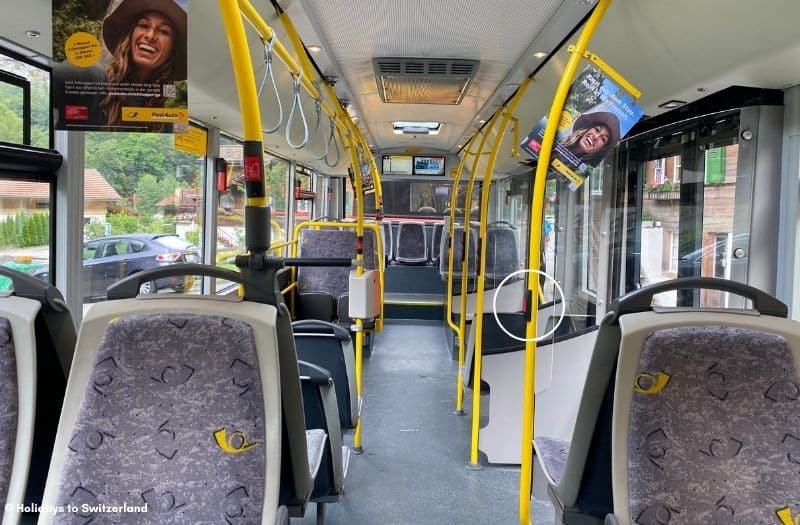
Travelling by boat – Swiss rail pass instructions
Swiss Travel Pass holders do not need to purchase any additional tickets for most boat trips in Switzerland. You can simply board the boat and sit in the correct class – the upper deck is for 1st class passengers and the lower deck is for 2nd class passengers.
Show your Swiss Travel Pass (or regional pass, if applicable) to the ticket inspector when requested.
Travelling by mountain railway – Swiss rail pass instructions
In order to board a mountain railway (cable car, funicular or cogwheel train), in many instances you need to proceed past the ticket counter and through a turnstile.
As a ticket is often required to be inserted into the turnstile in order for the gate to open, we recommend you stop at the ticket counter to present your rail pass, even if the ride is fully covered by your pass.
The ticket counter representative will either wave you through (if no access ticket is needed), issue you with the necessary ticket (if the ride is fully covered by your pass), or request payment at the discounted rate applicable to your rail pass.
You can see which mountain excursions are free and discounted with the Swiss Travel Pass here.
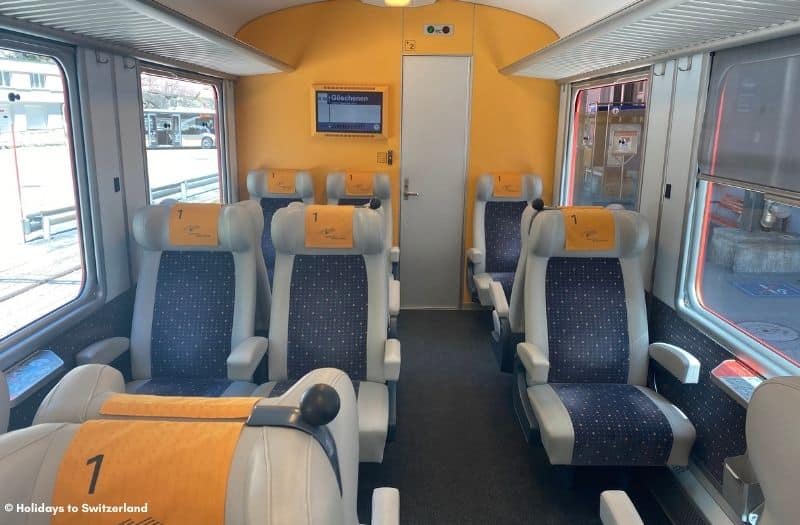
Travelling on public transport in Switzerland with a regular Swiss train ticket
When travelling by train in Switzerland it is essential that you purchase your ticket before boarding. On most trains there is no ticket machine or conductor on board so you must have your ticket before entering the train.
When requested, show your ticket (and seat reservation if you are travelling on a panoramic train) to the ticket inspector.
Bus tickets can be purchased from the driver upon entry. You should enter through the front door of the bus.
Tickets for boats and mountain railways can be purchased at the ticket counter before boarding.
Random ticket checks do occur and heavy fines apply to passengers who do not have the correct ticket.
You may sit in any free seat (in the correct class of travel) on trains*, buses, boats and mountain railways.
*except panoramic trains
Taking luggage on Swiss trains
Although there is not a huge amount of space for storing luggage on Swiss trains, most trains do have a dedicated luggage storage area in the area close to where you board the train.
Some trains also have space under and between the seats where luggage can be stored.
There are also overhead racks above the seats where you can place small luggage.
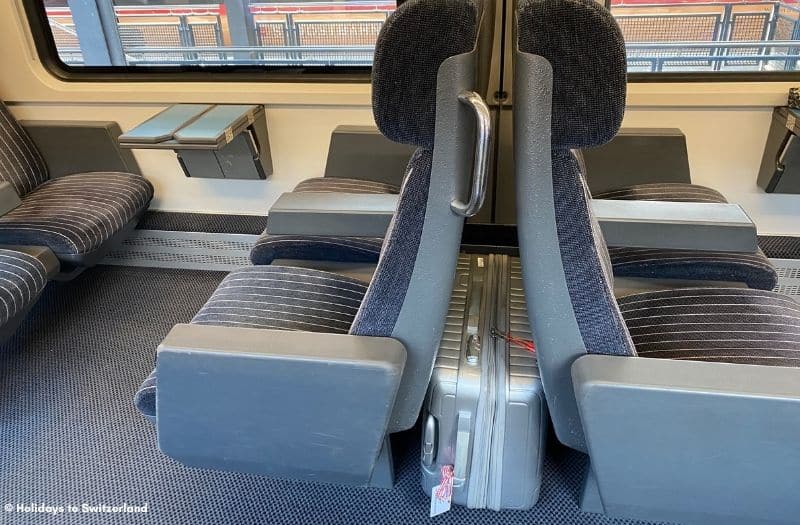
How much luggage can I bring?
Whilst there is no restriction on the Swiss trains as to how much luggage you can bring, it is highly recommended that you limit yourself to a medium sized suitcase and one piece of hand luggage or a backpack.
There is no porter service in Switzerland so you have to take care of your luggage. You are required to bring your own luggage to the platform and to carry it onto the train.
However, there is always a ramp or an elevator or an escalator at the station and step-free access to the platform. For this reason, a suitcase with wheels works perfectly.
Luggage shipping services
If you would prefer not to have to travel with your luggage, SBB offers a luggage shipping service. This can be a good option if you’d like to ship some of your luggage ahead for the next part of your vacation, or you’d like to stop off en route to do some sightseeing.
There are a variety of luggage shipping options available, such as:
- Luggage from station* to station* (2 days later): Take your luggage to a station* and 2 days later collect it from your destination station*.
- Luggage from door to door (Same day or next day): They will collect your luggage from an address in Switzerland and deliver it to your address. This is great for hotel to hotel luggage transfers.
- Luggage from station* to door (2 days later): Take your luggage to a station* and they will deliver it to your address 2 days later.
*not all stations offer this service.
Useful information about the best public transport system in the world in Switzerland
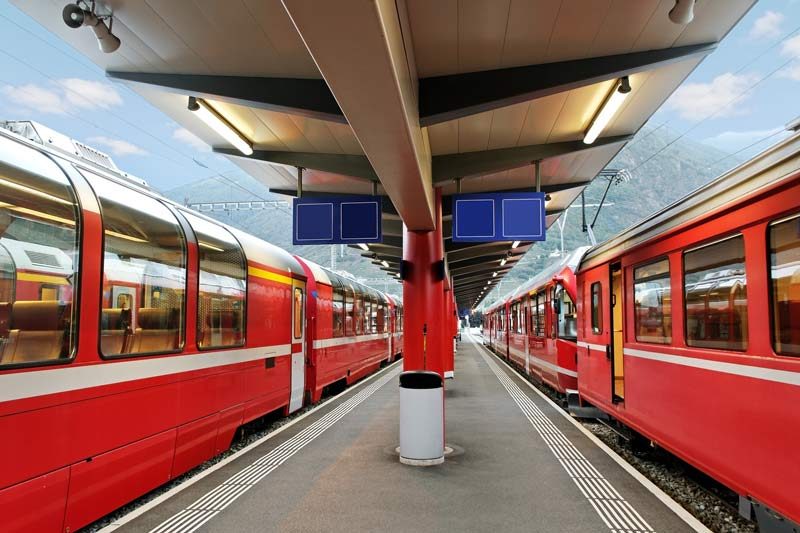
Advantages of train travel in Switzerland
Traveling by train in Switzerland has many advantages. Not only is Switzerland train travel a wonderful way to see the beautiful countryside and stunning Swiss Alps, it is also the most efficient and often the cheapest way to travel in Switzerland.
Here is a brief overview of the advantages of traveling by train through Switzerland:
- Centre to centre – travel in Switzerland by train is super convenient with pretty much the entire country well serviced and stations are located right in the centre of town.
- Travel like the locals – when you take a Switzerland train ride, you will be getting around just as the Swiss do.
- Relaxing – Rather than driving a hired vehicle for your Switzerland trip, sit back and relax, while you are transported to wherever you need to go. A train ride through Switzerland is extremely comfortable and a great way to relax on your holiday.
- Frequent – The Swiss Federal Railways are extremely efficient and trains are very regular. You’ll rarely wait long for any connections for your train trips through Switzerland.
- Scenic – Switzerland would have to be one of the most beautiful places in the world to travel by train – the landscape is absolutely perfect for train travel. The Swiss rail network goes right past the most scenic landscapes including all the stunning lakes, snow capped mountains, flowing streams and quaint little villages. In Switzerland it’s certainly more about the journey rather than the destination.
The Swiss Rail Network
The Switzerland train system is just brilliant, with the entire country well-connected enabling you to pretty much travel anywhere you wish. The Swiss rail system is said to be the world’s densest railway network and the trains are well connected with other forms of public transport.
The entire public transport system operates with a fully integrated timetable which means there are seamless connections between Swiss rail, bus, boat, tram and mountain railway services.
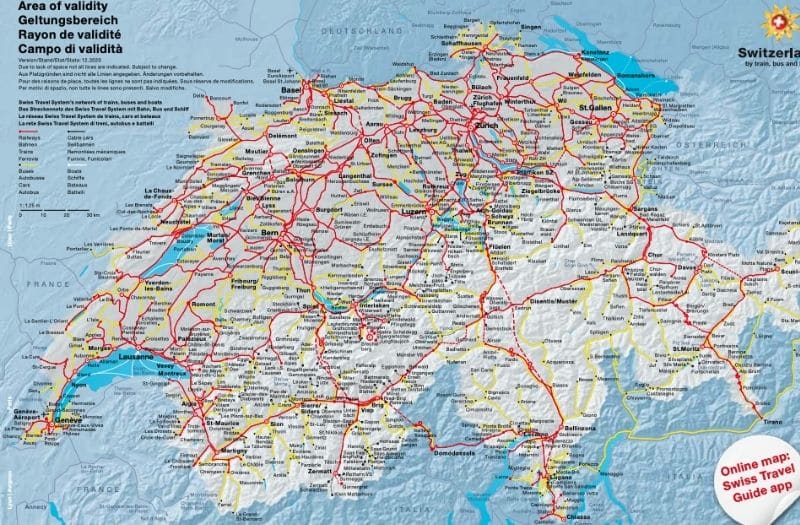
Major train routes in Switzerland
Below we have listed the details of some of the major Swiss train routes.
- Zurich to Lucerne train: A direct journey time between 45 minutes to just over 1 hour depending upon the train. The fastest route is train 70 which has a journey time of 45 minutes and only two stops, or train 75 with a journey time of 50 minutes and four stops. Trains to Lucerne run regularly at around every 30 minutes.
- Zurich to Interlaken train: A journey time between just over 2 hours to 3.5 hours with a connection in either Bern or Lucerne. A direct service operates from Zurich Airport and Zurich to Interlaken every two hours.
- Zurich to Geneva train: A direct journey time of around 2.75 hours. Trains to Geneva run regularly at around every 1 hour.
- Zurich to Basel train: There are multiple options which take between just under 1 hour to a little over an hour. The fastest route is train 2-Y which is a direct route traveling towards Mulhouse Ville and takes just under 1 hour. Another good option is to connect in Olten with a total journey time of 1 hour.
- Zurich to Zermatt train: This a 3.25 hour journey which requires a connection in Visp. Some routes require a connection in both Bern and Visp, but don’t add much time to the journey.
- Zurich to Bern train: A direct journey time of between just under 1 hour to 1.5 hours. For the fastest journey take train 8 towards Brig which is a direct trip, other routes require a connection in Olten or Aarau. Trains to Bern run regularly at around every 20 minutes.
- Geneva to Zurich train: A direct journey time of around 2.75 hours. Trains to Geneva run regularly at around every 1 hour.
- Geneva to Zermatt train: This is a 3.75 hour journey which requires a connection in Visp. Some routes require a connection in both Bern and Visp, but don’t add much time to the journey. Trains to Zermatt run regularly at around every 1 hour.
SBB Mobile – the essential app for travelling in Switzerland by train
Before you start travelling in Switzerland by train, we highly recommend you download the Switzerland public transport app, SBB Mobile.
This app is vital if you plan to travel by train in Switzerland – or any means of public transport – and will make your travel so much easier.
On the app you will be able to purchase point to point Swiss train tickets online, check all the train routes Switzerland has, look up SBB timetables (and timetables for all the public transport operators) and find out which platform your train departs from.
Another handy use for the SBB Mobile app is checking where you should stand on the platform. For instance, if you are wondering ‘where is first class on Swiss trains?’, the app can tell you exactly whereabouts on the platform the first class and second class carriages will stop.
All information is displayed in real time so if there’s a delay (which is rare in Switzerland) or you’d like to follow your journey live, you can do so on the app.
Would you like to save this article?
We promise never to spam you.
🇨🇭 Read our guide to using the SBB Mobile app when you travel Switzerland.
Panoramic Trains in Switzerland
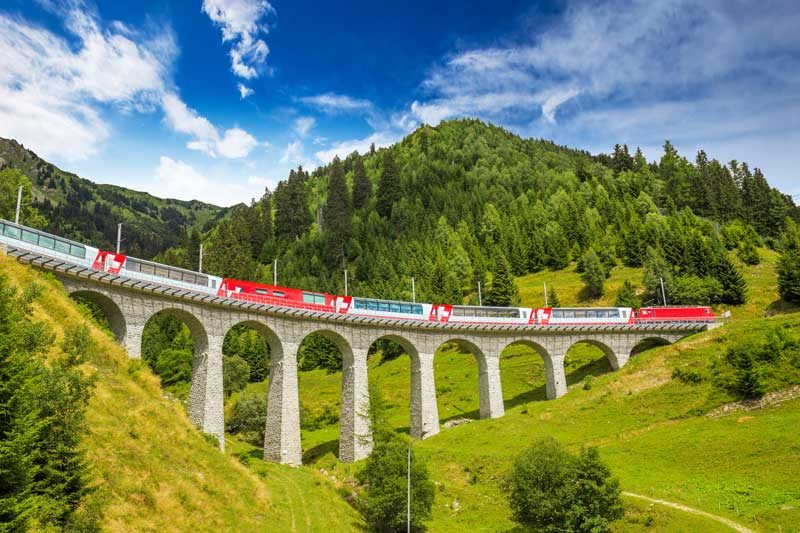
For many people on holidays in Switzerland, a trip on a Switzerland scenic train is at the top of the must-do list.
A panoramic train in Switzerland takes you through some of the most beautiful regions in all of Switzerland, with many of the trains having specially built panoramic windows to maximise your view.
Below you’ll find an overview of these scenic train routes in Switzerland.
Glacier Express
The Glacier Express is referred to as the “world’s slowest express train” and is also known as one of the most scenic train rides in Switzerland.
This scenic train in Switzerland runs between St Moritz and Zermatt and crosses 291 bridges and passes through 91 tunnels.
The entire scenic train of Switzerland trip is just over 8 hours and runs twice a day during the Winter months and four times a day during the Summer months – however please note that only two trains complete the entire journey.
Seat reservations are compulsory on the Glacier Express – even for Swiss Travel Pass holders – and start at CHF 39 per person.
🇨🇭Read our detailed guide to the Glacier Express.
Gotthard Panorama Express
Running between Lucerne and Lugano, this panoramic train of Switzerland starts by taking a cruise across Lake Lucerne in a steamboat before passengers board the train at Flüelen.
En route you will pass through the world’s longest tunnel.
The entire train trip through Switzerland takes 5.25 hours and runs once a day Tuesday through to Sunday during the months of late April to late October.
Seat reservations are compulsory for all passengers and cost 16 CHF.
🇨🇭Read our guide to the Gotthard Panorama Express.
Bernina Express
This iconic Switzerland rail journey takes you from the medieval city of Chur across the Swiss Alps to Italy.
The train journey passes through the UNESCO World Heritage Site of Rhaetian Railway as well as through 55 tunnels and crosses 196 bridges before ending at Tirano.
From here you can take the Bernina Express Bus through the Valtellina wine region before arriving in Lugano.
The entire journey takes almost 7.5 hours (4.25 on the train and the remaining time on the bus). The train trip runs twice daily.
Seat reservations are required for this trip and start from CHF 20 each for both the train and the bus.
🇨🇭Read our guide to the Bernina Express.
Voralpen-Express
This scenic train route in Switzerland connects St Gallen and Lucerne and takes just over 2 hours.
Along the way you pass lakes, mountains and the Rothenthurmer Hochmoorebene which is the highest railway viaduct in Switzerland at 99 metres high.
This train trip runs daily each hour. Advance reservations cannot be made for this train.
GoldenPass Line
Over two different connecting trains, the GoldenPass Line runs between Lucerne and Montreux and passes by eight lakes, through six different cantons (Swiss regions) and crosses three mountains passes.
The entire trip on the Golden Pass train in Switzerland takes just over five hours and runs five times a day, all year round.
Seat reservations are not required but are recommended during peak times. Seat reservations range between 5 and 8 CHF per person per sector.
🇨🇭 Read our guide to the GoldenPass Line.
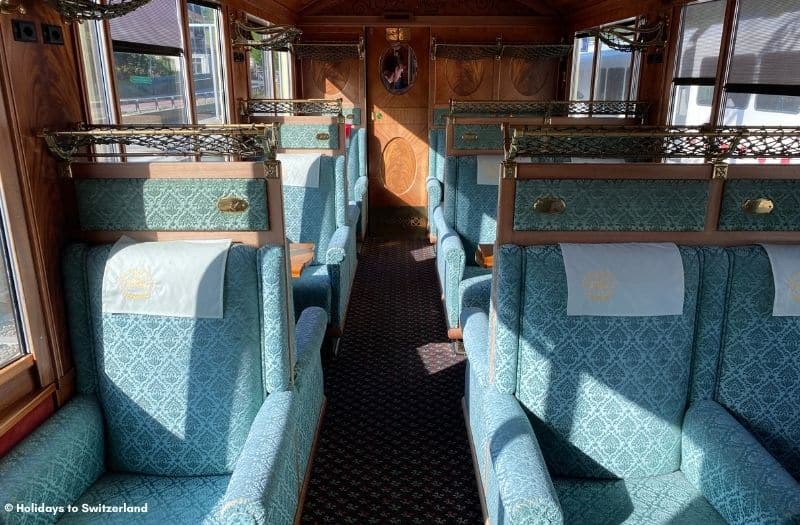
More scenic train routes in Switzerland
Centovalli Railway
The Centovalli Railway route takes passengers between Locarno and Domodossola and runs through the Centovalli (the Hundred Valleys) which provides some of the most beautiful views in all of Europe.
En route you will see waterfalls, vineyards, forests and quaint villages.
The entire journey takes just over 1 hour and operates year-round, departing every 1 to 2 hours.
Seat reservations are required.
🇨🇭 Read more about the Centovalli Railway.
The Chocolate Train Switzerland
For lovers of all things chocolate – a trip on the Chocolate train in Switzerland is a must. The Chocolate train tour Switzerland takes passengers between Montreux and the Cailler-Nestle chocolate factory at Broc.
The train journey itself is relatively short, but with the included stops at the chocolate factory as well as the Gruyères village, this trip takes the entire day.
The Chocolate train departs at 9.02 am and returns at 5.52 pm on Mondays, Tuesdays, Wednesdays and Thursdays between the months of May and June.
It operates daily during July and August, and in September and October services run on Mondays, Wednesdays and Thursdays.
The Chocolate Train costs 90 CHF for second class or 99 CHF for first class.
The ticket price includes entry to the chocolate factory of Nestlé Cailler in Broc, entry to La Maison du Gruyère and coffee and chocolate croissants on the train.
The Cheese Train Switzerland
If chocolate’s not your thing, there is also a Cheese train! Operating from February to June and September to November, the Cheese Train takes passengers between either Zweisimmen or Montreux and Chateau d’Oex.
Passengers learn the secrets of making Swiss Alpine cheese and enjoy a fondue cooked in the traditional way.
A visit to the House of Ballooning and to see an exhibition of GoldenPass MOB miniature trains are also included in the excursion.
The Cheese Train operates on Wednesdays, Fridays, Saturdays and Sundays during the months mentioned above (to 13 November only).
Onboard the trains
Below you’ll find some useful information about the trains in Switzerland.
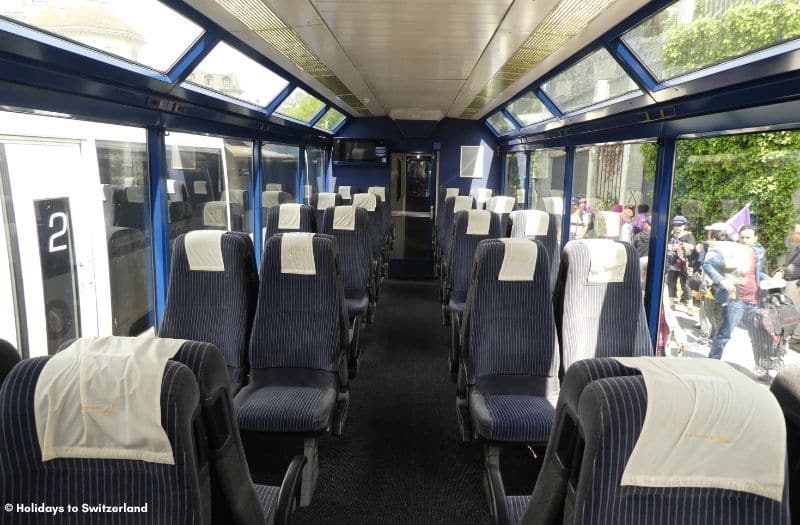
First Class or Second Class?
Most high speed trains offer a choice of both first and second class carriages (called Coaches). First class seats usually recline and have more legroom. There are generally fewer seats per coach and more space for luggage.
Some high speed trains include a meal in the ticket price (often served to your seat) and where this doesn’t apply, meals and snacks are available for purchase from a dining car or snack cart.
First class coaches are usually quieter with more business and adult passengers travelling in first class coaches. They include power outlets to charge your mobile devices.
Second class seats are less expensive, but not as spacious as there are more seats per car, and often these will be in a compartment-style layout with two bench seats (each seating three people) facing each other.
Meals and snacks can be purchased from a dining car or snack cart.
Second class coaches often have more passenger than first class coaches as more Europeans tend to travel in second class.
Quiet Zones
A quiet zone can be found in first class coaches on certain routes. The areas are well marked and in these areas you should refrain from talking, making phone calls, listening to music (even with headphones) or playing any games on electronic devices.
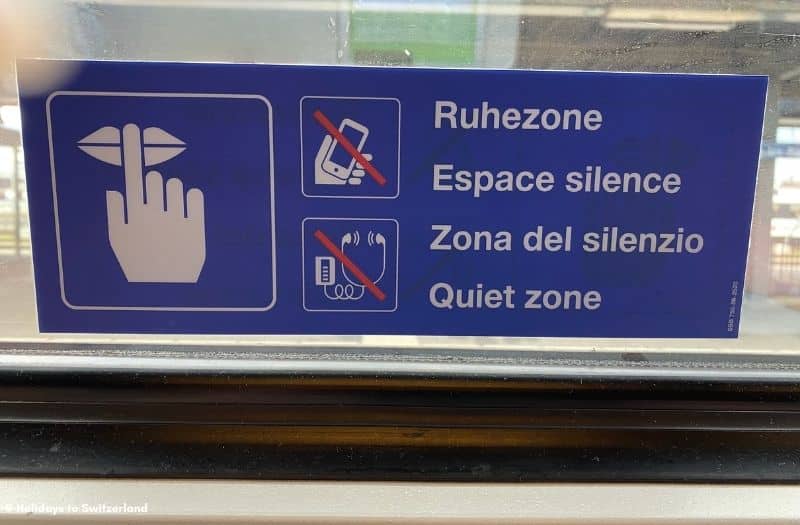
WiFi
Whilst there is no free WiFi on Swiss trains, you can use your smartphone as a personal hotspot. You will need a compatible SIM card with data to access the 3G/4G network.
Free internet access is available at 80 railway stations in Switzerland. The service is limited to 60 minutes.
Onboard Restaurants and Bistros
If you’ve wondered “can you eat on Swiss trains?”, the answer is most definitely yes. Most InterCity and EuroCity trains have a restaurant or bistro onboard.
Passengers can usually eat at the restaurant or take it away to their seats. Passengers in first class also have the option of being served at their seat on some trains.
The Family Coach
For families travelling with young children, you are going to want to visit the family coach – which is basically a playground on the train. All double decker InterCity trains on long distance routes have a family coach.
You’ll know if a family coach is on your train as it will be marked on the timetable with ‘FA’.
InterCity tilting trains don’t have the Family Coach but they do have board games available for families at the games tables specially provided on board.
The Family Zone
Another great area for families on single deck InterCity or InterCity tilting trains are the family zones. These areas have much more room for prams, and parents can relax not worrying about their children being too loud and distracting other passengers.
You’ll find the family zone at the very front or very rear of the train.
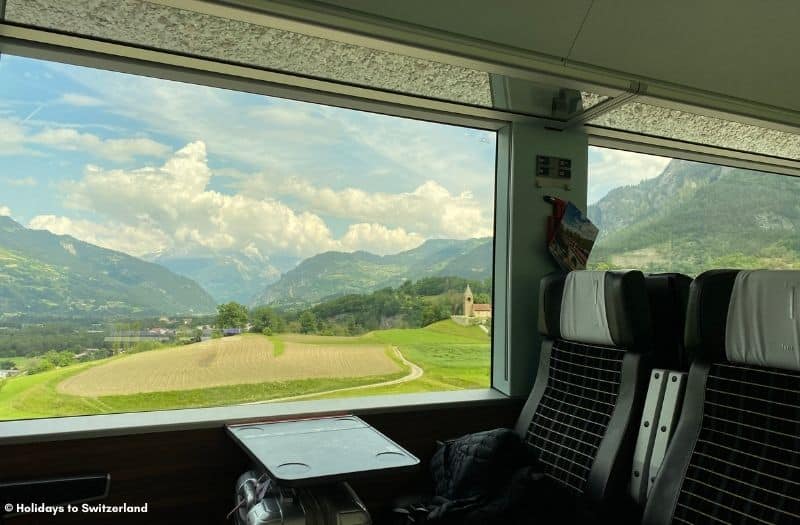
FAQs about train travel in Switzerland
How far in advance can I book my Swiss train tickets?
Like budget airlines, the cheapest fares are usually available to those that book early, therefore it is recommended that you make your reservations as soon as you possibly can.
Most Swiss trains, including the panoramic trains, can be booked 90 days prior to travel.
Where can I find a Swiss train timetable?
Up to date Swiss train timetables can be found on the Swiss Federal Railways website, on the handy SBB Mobile app or you can pick one up from the nearest station.
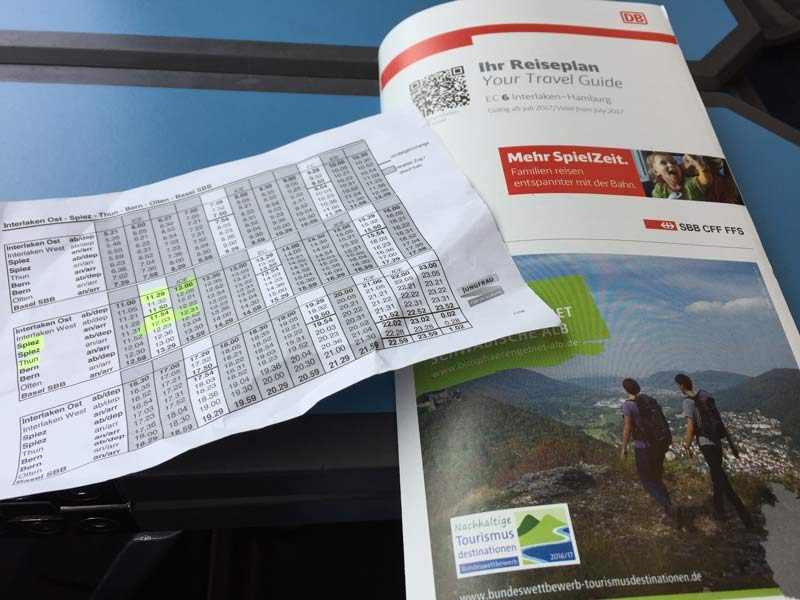
Do I need seat reservations on Swiss trains?
No, in general for most trains in Switzerland you do not need any reservations. Seat reservations are only compulsory on the premium panoramic trains – Glacier Express, Bernina Express, GoldenPass Express and Gotthard Panorama Express.
How do I make seat reservations on Swiss trains?
Regular trains
If you need to (or want to) make a seat reservation for your train holidays to Switzerland you can do so via the SBB website, mobile app or at the ticket counter at a station. It costs CHF 5 per seat to make a reservation. Higher charges apply for the panoramic trains.
Panoramic trains
If you hold a Swiss Travel Pass and you wish to make seat reservations for one of the panoramic trains, you can do so on the official website of the train.
We include links to the official train websites and step-by-step instructions for purchasing your seat reservations in our articles about the various panoramic trains that we have mentioned above.
Can I buy tickets at the station?
Yes, you can buy tickets at the train stations in Switzerland – you can do this either via a ticket machine or at the ticket counter (if there is one).
Can I buy Swiss rail tickets onboard?
No, you must have a valid ticket before boarding the train.
Are trains in Switzerland safe?
Yes, traveling on trains in Switzerland is very safe. However, it is best to use common sense, be cautious for your own protection and keep your valuables on your person or in sight at all times.
What do I do if I lose my ticket or rail pass?
Most tickets and rail passes are issued as e-tickets. We recommend you keep the original PDF of your ticket (or take a screenshot of the ticket on your mobile device) and print this out or upload it to the Cloud.
If you lose your e-ticket or the e-rail pass or your device gets lost or stolen, you can then simply reprint it from the PDF. If you lose a ticket you have purchased from a ticket machine at the station, unfortunately it cannot be reissued or replaced.
Planning a trip to Switzerland?
At Holidays to Switzerland we are passionate about sharing our love of Switzerland and helping you to plan the perfect trip. Read our guide to planning a trip to Switzerland to kick start your travel plans and join our free Switzerland Travel Planning group on Facebook to chat with other past and future travellers.
Want monthly news and podcast updates, helpful travel tips and special deals sent straight to your inbox? Subscribe to Holidays to Switzerland and we’ll send you a bonus copy of our 21 Useful Things to Know Before You Visit Switzerland guide.
🇨🇭 Check out our exclusive discount offers and save on your Swiss vacation. 🇨🇭
What is the most common transportation in Switzerland?
Train travel is the most popular way to get around Switzerland.
Is public transport free in Switzerland?
Public transport is not free in Switzerland however it is possible to purchase day passes and rail passes that include travel on public transport.
Do trains run on Sunday in Switzerland?
Yes, trains run seven days per week in Switzerland.
How late do trains run in Switzerland?
It depends on the actual route but most trains in Switzerland run until around midnight.
Why are Swiss trains so good?
Switzerland’s rail network has an excellent reputation due to the frequency and punctuality of its services. The trains in Switzerland are also very clean and comfortable which makes getting around in Switzerland a pleasant experience.
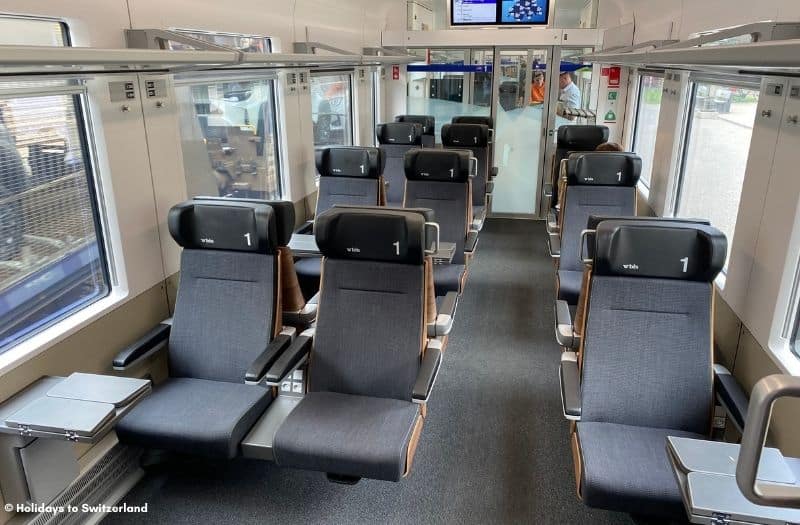
General tips for travelling by train in Switzerland
Whilst rail travel in Switzerland is relatively easy (and very relaxing), there are a few things you should be aware of before you get to the station to ensure you have a smooth departure.
- Arrive at the station in plenty of time. Some stations in Switzerland are huge and it can take a while to get your bearings and get to the correct platform. At really busy stations where there are trains arriving and departing every few minutes, the platform number from which your train is departing may not be advised until 20 minutes before departure. As soon as the platform number is displayed, there’s a huge crush to get there, so give yourself plenty of time.
- Check the overhead boards for the correct train number and the platform from which your train departs. Remember that the destination on the board may be further along the line than you are travelling, therefore your destination may not show. Each train has a train number, just like a flight number, for this purpose. Always match the train number on your ticket to the train number on the overhead board.
- When purchasing an individual (or point-to-point) train ticket, you are usually allocated a specific seat in which to sit and the seat number and carriage number will be printed on your ticket. This applies to most trains however some regional trains which only offer second class carriages are ‘non-reserved’ and you can sit anywhere you like.
- At the platform, check for signs showing where each carriage will stop. The train layout is displayed at most stations and is also in the SBB app. If you are in coach (carriage) #06, for example, some stations have signs showing at which point on the platform coach #06 will stop. In the photo below you can see that coach #06 will stop at Section V on the platform, so by waiting in the correct area, you will be in the right place when the train pulls up. Smaller stations may not have such specific signage but will usually show you where the 1st class and 2nd class coaches will stop.
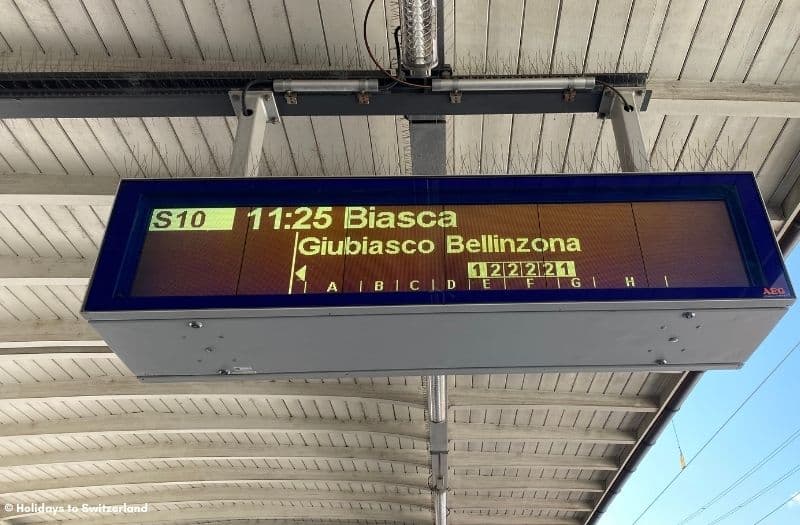
- Stopping times at stations can be short – three or four minutes is not uncommon. Be ready to board the train (or join the boarding queue) as soon as the train arrives at the station. When lots of people are trying to board the train with heavy luggage it can be congested, so be prepared. If you’re travelling with children or older folks, let them board first without their luggage and pass all the luggage up to them once they are on the train.
- Most train services in Switzerland are precisely on time! In most instances they arrive at the station at exactly the time they are scheduled to, so don’t be late.
- Make sure you know the name of the station at which you should disembark in the local language. Lucerne is called Luzern and Geneva is called Geneve, for instance.
- If you are purchasing a ticket locally or don’t have a seat reservation for your journey, make sure you are boarding the correct carriage of the train. Some trains split at a designated station during their journey with the engine and the front carriages continuing to one destination whilst another engine is attached to the remaining carriages and travels to another end station. In these instances, each carriage usually displays a sign on the outside indicating the end station it is travelling to.
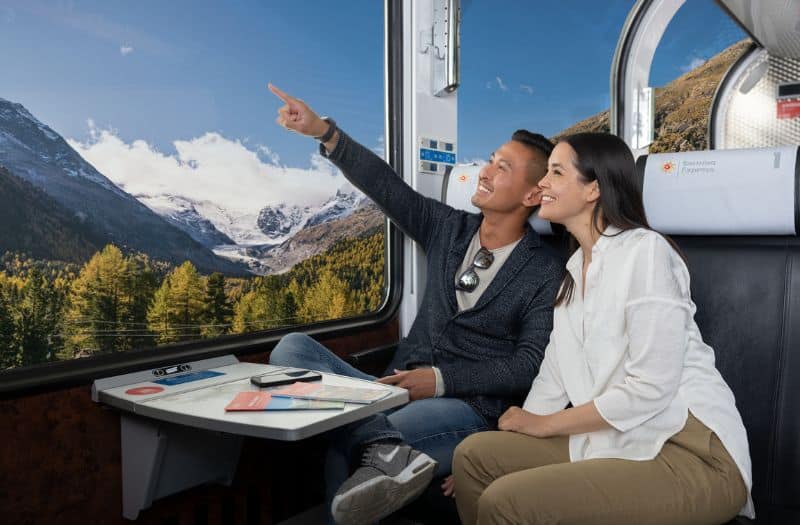
Final thoughts about train travel in Switzerland
We hope this guide to travelling by train in Switzerland has given you a better understanding of the Swiss rail system. Getting around Switzerland by train is a relaxing and scenic way to travel between destinations.
Whether you choose to purchase point-to-point train tickets in Switzerland or buy a Swiss rail pass for your travels, you’ll be impressed by the efficiency and punctuality of the Swiss public transport system.
Listen to our podcast episode about the Swiss public transport system
PIN FOR LATER


